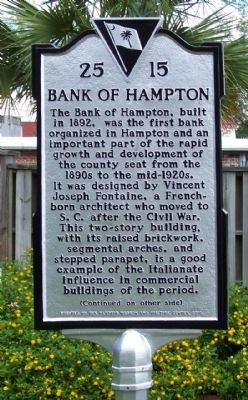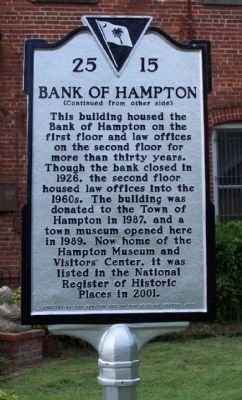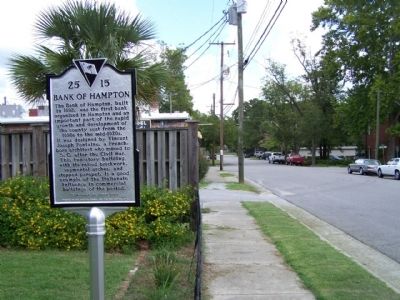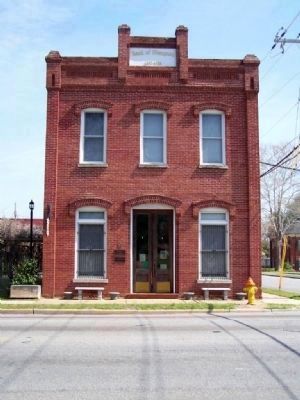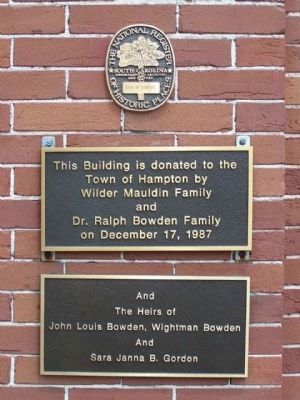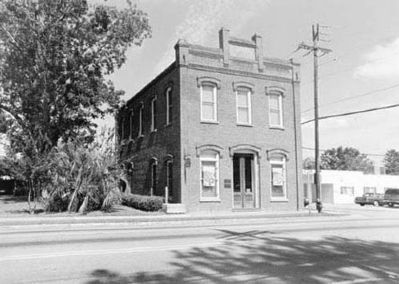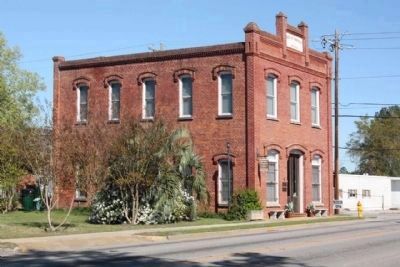Hampton in Hampton County, South Carolina — The American South (South Atlantic)
Bank of Hampton
The Bank of Hampton, built in 1892, was the first bank organized in Hampton and an important part of the rapid growth and development of the county seat from the 1890s to the mid-1920s. It was designed by Vincent Joseph Fontaine, a French-born architect who moved to S.C. after the Civil War. This two-story building, with its raised brickwork, segmental arches, and stepped parapet, is a good example of the Italianate influence in commercial buildings of the period.
(Reverse text)
This building housed the Bank of Hampton on the first floor and law offices on the second floor for more than thirty years. Though the bank closed in 1926, the second floor housed law offices into the 1960s. The building was donated to the Town of Hampton in 1987, and a town museum opened here in 1989. Now home of the Hampton Museum and Visitors' Center, it was listed in the National Register of Historic Places in 2001.
Erected 2010 by The Hampton Museum and Visitors' Center. (Marker Number 25-15.)
Topics. This historical marker is listed in this topic list: Notable Buildings. A significant historical year for this entry is 1892.
Location. 32° 51.991′ N, 81° 6.486′ W. Marker is in Hampton, South Carolina, in Hampton County. Marker is on 1st Street East, on the left when traveling north. Located between Elm Street East(US 278)and Mulberry Street East. Touch for map. Marker is in this post office area: Hampton SC 29924, United States of America. Touch for directions.
Other nearby markers. At least 8 other markers are within walking distance of this marker. Hampton County (within shouting distance of this marker); Miles McSweeney Home Site (about 400 feet away, measured in a direct line); All Wars Memorial (about 500 feet away); Site of Hampton High School (approx. 0.3 miles away); James Washington Moore House (approx. 0.4 miles away); World War II POW Camp (approx. 0.7 miles away); American Legion Hut (approx. 0.7 miles away); Hampton Colored School (approx. 0.7 miles away). Touch for a list and map of all markers in Hampton.
Regarding Bank of Hampton. National Register of Historic Places:
Bank of Hampton (added 2001 - Building - #01000606)
♦ Historic Significance: Event, Architecture/Engineering
♦ Architect, builder, or engineer: Fontaine, Vincent Joseph
♦ Architectural Style: Italianate
♦ Area of Significance: Commerce, Architecture
♦ Period of Significance: 1875-1899, 1900-1924, 1925-1949
♦ Owner: Local Gov't
♦ Historic Function: Commerce/Trade
Additional commentary.
1. Bank of Hampton
In 1891, several prominent citizens of the town of Hampton organized the Bank of Hampton. Purchasing a lot across from the County Courthouse, they engaged architect/builder Vincent J. Fontaine to construct a prominent edifice for the new bank. Fontaine, a French immigrant, studied architecture in Italy before moving to South Carolina in the early 1870s. The two-story Italianate influenced brick building was completed in 1892. The building features segmental arches over
door and window openings, and low flat parapets at the side elevations. As the county seat, Hampton had six lawyers by 1883, several of which rented upstairs offices. Establishment of the bank was an important factor in securing the town’s position as a regional center, and by 1905 Hampton was listed as a “banking town” in a statewide business directory. The Bank of Hampton operated successfully until 1926, and three years later the building was purchased from its
receivers by their competitors, The Loan and Exchange Bank. From the 1930s to the 1960s the building was operated as rental commercial space, still maintaining the upstairs law offices. In 1987, heirs of the buildings’ owners gave it to the town of Hampton.(South Carolina Department of Archives and History)
— Submitted September 14, 2010, by Mike Stroud of Bluffton, South Carolina.
Credits. This page was last revised on June 16, 2016. It was originally submitted on September 14, 2010, by Mike Stroud of Bluffton, South Carolina. This page has been viewed 890 times since then and 12 times this year. Photos: 1, 2, 3, 4, 5, 6, 7. submitted on September 14, 2010, by Mike Stroud of Bluffton, South Carolina. 8. submitted on April 5, 2011, by Mike Stroud of Bluffton, South Carolina.
